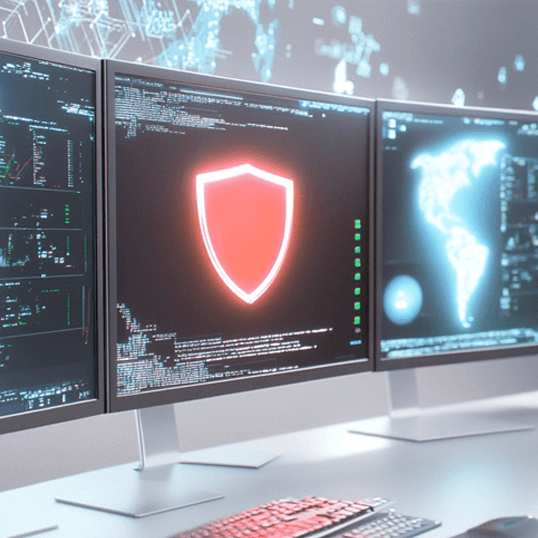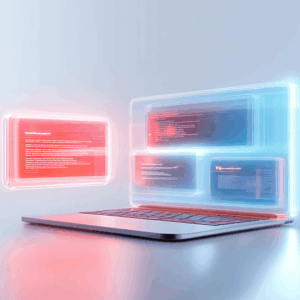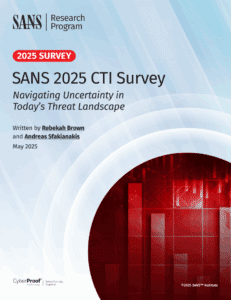In today’s digital era, where cyber threats loom larger and more sophisticated than ever, the importance of Cyber Threat Intelligence (CTI) cannot be overstated. CTI emerges as a pivotal asset for teams who bear the critical responsibility of safeguarding their organizations’ digital frontiers. At its core, CTI encompasses the collection, analysis, and dissemination of information about current and potential attacks that threaten the security of an organization’s information assets.
The adoption of CTI signifies a shift from a reactive to a proactive cybersecurity posture, enabling cyber threat intelligence analysts to make informed decisions based on high-level, actionable data. Security teams are equipped to identify, assess, and prioritize threats in real-time, ensuring that defensive measures can be dynamically adjusted to counter emerging cyber threats efficiently. This strategic approach to cybersecurity not only enhances an organization’s resilience against cyber attacks but also fosters a culture of continuous improvement and learning within cybersecurity teams.
For CISOs, CIOs, and SOC Managers, embracing CTI means gaining a strategic advantage in the cybersecurity arms race against external threats, potential risks, and malicious activity. It allows for a deeper understanding of the motives, tactics, techniques, and procedures (TTPs) of threat actors, facilitating a targeted defense strategy that aligns with the specific threat landscape an organization faces.
As we delve further into the nuances of CTI, its components, and its implementation, it becomes clear that CTI is an indispensable tool in the arsenal of modern cybersecurity professionals, paving the way for a more secure and resilient digital future.
Understanding Cyber Threat Intelligence
Cybersecurity Threat Intelligence stands as a beacon of proactive defense, guiding organizations through the murky waters of digital threats. CTI is not merely about gathering data; it’s about translating that data into actionable insights that can prevent cyber incidents before they occur. This intelligence-driven approach enables businesses to anticipate attackers’ moves, understand their tactics, techniques, and procedures (TTPs), and strengthen their security posture accordingly.
At its core, CTI encompasses a variety of data sources, including but not limited to indicators of compromise (IoCs), tools used by threat actors, and detailed threat analyses. This information is gathered from a myriad of channels—open source intelligence (OSINT), social media, deep and dark web sources, and more. The essence of CTI lies in its ability to not only react to existing threats but also to predict future threats based on the cyber threat landscape.
The strategic application of CTI within an organization’s cybersecurity framework can drastically enhance its ability to fend off sophisticated cyber attacks. By integrating CTI, businesses can shift from a reactive security posture to a more dynamic, predictive approach. This shift is critical in today’s digital age, where the complexity and frequency of cyber attacks are always rising.
Moreover, CTI plays a pivotal role in risk management. By providing detailed insights into potential threats and their impact, CTI enables organizations to allocate resources more effectively, prioritize security measures, and make informed decisions that align with their risk appetite and security objectives. In essence, CTI transforms raw data into a strategic asset, empowering businesses to stay one step ahead of cyber adversaries.
The Core Components of CTI
Cyber Threat Intelligence is an intricate ecosystem composed of several critical components, each playing a unique role in fortifying an organization’s cybersecurity defenses. Understanding these components is essential for CISOs, CIOs, and SOC Managers as they navigate the complexities of today’s cyber threat landscape.
Threat Intelligence Feeds
Threat Intelligence Feeds are continuous streams of data related to threats, which are collected from various sources around the globe. These feeds include information on known malicious IPs, URLs, hash values of malware files, phishing sites, and more. They act as the lifeblood of CTI, providing the raw materials needed for threat identification. By aggregating and filtering through cyber threat intelligence feeds, organizations can identify emerging threats in real-time, allowing for swift preventive measures.
Cyber Intelligence Analysts
At the heart of CTI are the Cyber Intelligence Analysts—skilled professionals who dissect, interpret, and contextualize the data obtained from intelligence feeds. These analysts employ a combination of technical expertise and critical thinking to identify patterns, assess threat credibility, and determine potential impacts on the organization. Their analyses contribute to the development of a comprehensive understanding of the threat environment, enabling the formulation of strategic security measures tailored to the organization’s specific vulnerabilities and threat exposure.
Threat Intelligence Platforms
Supporting the work of cyber intelligence analysts are Threat Intelligence Platforms (TIPs). These platforms serve as centralized hubs for collecting, aggregating, correlating, and analyzing threat data from various intelligence feeds.
Threat intel platforms streamline the process of turning vast amounts of unstructured data into organized, actionable intelligence. They offer cyber threat analysts the tools to automate, visualize, and integrate with existing security systems, enhancing the efficiency of threat detection, investigation, and response. By using threat intelligence tools and cyber threat intelligence platforms, security teams can rapidly assess threat levels, prioritize actions based on risk, and disseminate intelligence across the organization for coordinated defense efforts.
Threat intelligence software, cyber threat intelligence tools, and threat intelligence analysts form the backbone of an effective CTI strategy. Threat Intelligence Feeds offer a continuous input of potential threats, Cyber Intelligence Analysts interpret and prioritize these threats, and Threat Intelligence Platforms provide the technological support needed to manage and operationalize the intelligence. This triad enables organizations to develop a proactive, intelligence-led cybersecurity posture, significantly reducing their vulnerability to cyber attacks and enhancing their overall security resilience.
Implementing CTI: Best Practices
Integrating Cyber Threat Intelligence into an organization’s security strategy requires meticulous planning and execution. The objective is to ensure that CTI not only complements existing security measures but also enhances the organization’s ability to detect, respond to, and prevent cyber threats. Here are some best practices for implementing CTI effectively:
- Define Clear Objectives: Before embarking on the CTI journey, it’s crucial to define what your organization aims to achieve with CTI. Whether it’s enhancing detection capabilities, improving incident response times, or gaining a deeper understanding of the threat landscape, having clear objectives will guide the CTI integration process.
- Choose the Right Tools and Platforms: The market is replete with CTI tools and platforms, each offering a unique set of features. Selecting the right tools and/or threat intelligence services requires an understanding of your organization’s specific needs and the types of intelligence most relevant to your threat landscape. Consider tools that offer integration capabilities with your existing security infrastructure, such as SIEM systems, to streamline intelligence sharing and response actions.
- Establish a Dedicated CTI Team: Effective CTI implementation relies on having a team of skilled cyber intelligence analysts who can interpret and act on the intelligence gathered. This team should be responsible for managing CTI feeds, analyzing threat data, and disseminating intelligence across the organization.
- Integrate CTI Across Security Functions: CTI should not operate in isolation. Integrate CTI insights and threat intelligence solutions across all security functions, from prevention and detection to incident response and risk management. This integration ensures that intelligence informs every aspect of the security strategy, enabling a unified and proactive defense posture.
- Foster a Culture of Intelligence Sharing: Encourage intelligence sharing both within the organization and with external entities, such as industry-specific information sharing and analysis centers (ISACs). Sharing intelligence can provide broader insights into emerging threats and best practices for mitigation, enriching the organization’s threat intelligence.
- Continuously Evaluate and Adapt: The threat landscape is constantly evolving, and so should your CTI strategy. Regularly evaluate the effectiveness of your CTI efforts and be prepared to adapt tools, processes, and strategies in response to new threats and intelligence capabilities.
By adhering to these best practices, organizations can ensure that their cyber threat analysis is strategic, effective, and aligned with their overall cybersecurity goals. Ultimately, the successful integration of CTI will enhance an organization’s resilience against cyber threats, protecting its assets and stakeholders in an increasingly hostile digital environment.
Challenges and Solutions in CTI
Integrating Cyber Threat Intelligence into an organization’s cybersecurity strategy can encounter various challenges. Here are common obstacles and strategies to overcome them:
- Data Overload: One of the most daunting challenges in CTI is managing the sheer volume of data. Organizations often struggle to filter through the noise to find actionable intelligence. Solution: Implement advanced filtering and prioritization mechanisms. Utilize CTI platforms that offer automation and machine learning capabilities to sift through data efficiently, identifying and prioritizing threats relevant to your specific environment.
- Integration with Existing Systems: The effectiveness of CTI is significantly reduced if it cannot be seamlessly integrated with existing security tools and systems. Solution: Select CTI tools and platforms that offer robust integration capabilities with a wide range of security solutions. Use APIs to facilitate smooth data exchange and ensure that CTI feeds directly into your SIEM, incident response platforms, and other security tools.
- Skill Gap: The complexity of cyber threats requires skilled analysts who can interpret CTI and translate it into actionable strategies. However, there’s often a gap in the required expertise. Solution: Invest in training and development programs for your security team to enhance their CTI skills. Additionally, consider outsourcing or partnering with specialized CTI providers to access expert insights.
- Timeliness and Relevance: The rapidly evolving nature of cyber threats means that intelligence can quickly become outdated, reducing its relevance and effectiveness. Solution: Focus on real-time or near-real-time CTI feeds and ensure that your CTI processes are agile enough to adapt to new information. Establish direct relationships with trusted intelligence providers for timely updates.
- Cost: Implementing a comprehensive CTI strategy can be costly, especially for organizations with limited cybersecurity budgets. Solution: Start with open-source intelligence (OSINT) tools and community-shared intelligence to reduce costs. Prioritize investments in CTI tools and platforms that offer the most significant impact on your security posture, and consider shared intelligence solutions within industry groups or partnerships.
- Measuring Effectiveness: Demonstrating the ROI of CTI initiatives can be challenging, making it difficult to justify continued or increased investment. Solution: Establish clear metrics and KPIs to measure the impact of CTI on your security operations, such as reductions in incident response times, increased detection rates, and decreased impact of breaches. Use these metrics to communicate the value of CTI to stakeholders.
By addressing these challenges with strategic solutions, organizations can enhance the effectiveness of their CTI efforts, ensuring that they not only respond more efficiently to current threats but also proactively prepare for future cyber challenges.
Future of CTI: Trends and Predictions
As the digital landscape continues to evolve, so does the realm of Cyber Threat Intelligence. Organizations are increasingly recognizing the pivotal role that CTI plays in fortifying their cybersecurity defenses against sophisticated threats. The future of CTI is shaping up to be an exciting era, marked by significant advancements and shifts. Here are some key trends and predictions that will define the trajectory of CTI:
- Integration of Artificial Intelligence and Machine Learning: AI and ML technologies are set to revolutionize CTI by enhancing the ability to process vast amounts of data at unprecedented speeds. These technologies will enable more sophisticated analytics, predictions, and automation capabilities, making threat intelligence more actionable and timely. AI-driven CTI will significantly reduce false positives and enable security teams to focus on genuine threats.
- Automated Threat Hunting and Response: The future will see a greater emphasis on proactive threat hunting, powered by CTI. Automated threat hunting tools, informed by real-time intelligence, will scan networks for indicators of compromise even before specific threats are fully realized. This shift towards preemptive action will transform cybersecurity strategies and the work of cyber threat hunters from reactive to proactive.
- Increased Emphasis on Collaboration and Sharing: As cyber threats become more complex and pervasive, the importance of collaboration and intelligence sharing across industries and borders will become more pronounced. Platforms and frameworks that facilitate secure, anonymous sharing of threat intelligence will gain prominence, enabling a collective defense approach.
- Expansion of CTI to Address Emerging Technologies: As organizations adopt new technologies like IoT, 5G, and blockchain, CTI will expand its focus to cover the unique threat landscapes these technologies introduce. Tailored intelligence will be crucial for securing these emerging ecosystems against novel attack vectors.
- Strategic, Business-aligned CTI: CTI will increasingly be recognized not just as a technical tool, but as a strategic asset that informs business decisions. Intelligence reports will not only detail threats but also provide insights into geopolitical trends, industry-specific risks, and compliance implications, aligning closely with broader business objectives.
- Enhanced Focus on Human Elements: Despite advances in technology, the human element will remain central to CTI. The nuanced understanding that human analysts bring to the interpretation of data will be complemented by technology, not replaced by it. Training and retaining skilled CTI professionals will be a priority for organizations.
- Customization and Personalization of CTI Tools: As the one-size-fits-all approach becomes less effective, CTI tools will offer greater customization and personalization options. Organizations will be able to tailor their CTI solutions to fit their specific industry, size, threat profile, and security needs, making intelligence more relevant and actionable.
The future of CTI is marked by technological innovation, collaboration, and strategic integration into broader business and security strategies. As organizations navigate this evolving landscape, staying abreast of these trends will be crucial for enhancing their security posture and resilience against cyber threats.
In today’s rapidly evolving cyber threat landscape, Cyber Threat Intelligence emerges as a critical pillar for enhancing an organization’s security posture. By offering insights into potential threats before they materialize, CTI enables businesses to transition from a reactive to a proactive defense strategy. The implementation of CTI, guided by security professionals, best practices, and adapted to overcome prevalent challenges, equips organizations with the tools necessary to anticipate, identify, and mitigate cyber threats effectively.
As we look towards the future, the role of CTI in cybersecurity is poised to grow even more significant, driven by advancements in technology and an increasing emphasis on collaboration and intelligence sharing. The integration of AI and ML, the focus on automated threat hunting, and the strategic alignment of CTI with business objectives highlight the dynamic nature of this field.
For CISOs, CIOs, and SOC Managers, embracing CTI means not just enhancing their organization’s ability to fend off cyber attacks, but also ensuring that cybersecurity strategies are agile, forward-looking, and aligned with the broader goals of the organization. In essence, CTI is not just about securing data and systems—it’s about safeguarding the future of the business in the digital age.













